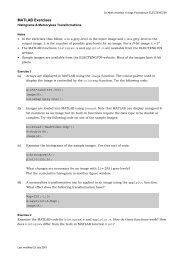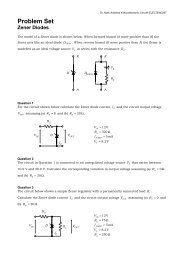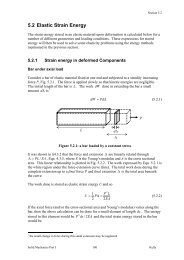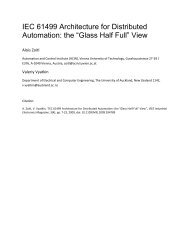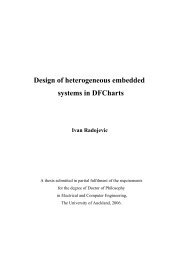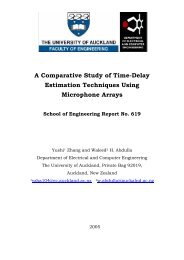Formal description of IEC 61499 control logic with - The University of ...
Formal description of IEC 61499 control logic with - The University of ...
Formal description of IEC 61499 control logic with - The University of ...
You also want an ePaper? Increase the reach of your titles
YUMPU automatically turns print PDFs into web optimized ePapers that Google loves.
e described in section 5. We will summarize our approach<br />
in section 6 and give an outlook to future work.<br />
II. RELATED WORK<br />
<strong>The</strong>re exist several approaches for the formal <strong>description</strong><br />
<strong>of</strong> <strong>IEC</strong> <strong>61499</strong> <strong>control</strong> <strong>logic</strong> that have been described <strong>with</strong>in<br />
the recent years. <strong>The</strong>y can be separated according to one<br />
significant property; whether they include beside the model<br />
for function blocks (FBs) also a model <strong>of</strong> the runtime<br />
environment (event propagation <strong>with</strong>in the FB network) or<br />
not.<br />
A. <strong>Formal</strong> <strong>description</strong> <strong>of</strong> pure function blocks<br />
<strong>The</strong> first approach for a formal <strong>description</strong> <strong>of</strong> FBs<br />
according to <strong>IEC</strong> <strong>61499</strong> has been published by Vyatkin and<br />
Hanisch [6]. <strong>The</strong>y use net condition event systems (NCES)<br />
and therefore are able to combine analogies <strong>with</strong><br />
<strong>IEC</strong> <strong>61499</strong>. NCES modules can be interconnected by event<br />
and condition arcs to even bigger modules. Event<br />
propagation is modeled directly by event arcs. <strong>The</strong>refore,<br />
the runtime behavior is not mentioned. Further work based<br />
on this approach uses closed-loop verification <strong>of</strong> the<br />
<strong>control</strong>ler and the plant. Appropriate tool support and<br />
automatic generation <strong>of</strong> the formal model <strong>of</strong> the system are<br />
further topics presented <strong>with</strong>in this approach.<br />
<strong>The</strong> work <strong>of</strong> Vyaktin and Hanisch builds also the basis<br />
for current work from Lüder et al. [9].<br />
Wurmus and Wagner [12] present an approach for the<br />
formal <strong>description</strong> by use <strong>of</strong> Petri Nets. An event is<br />
represented by the flow <strong>of</strong> markings. Event FBs like<br />
E_DELAY are modeled <strong>with</strong>out regard to a concrete<br />
implementation <strong>with</strong>in a runtime environment.<br />
Schnakenbourg et al. [10] propose to model FBs using a<br />
synchronous language called SIGNAL. <strong>The</strong>y use clocks to<br />
assure the synchronization between the Execution Control<br />
Chart (ECC) and the input events. <strong>The</strong>re is no model<br />
included for the propagation <strong>of</strong> events according to a<br />
concrete runtime implementation. Physical time is also not<br />
included, but the authors claim that this can be overcome<br />
by giving a value to the gap between two instances <strong>of</strong> a<br />
clock.<br />
A rather new approach has been presented by Dubinin<br />
and Vyaktin [13] using the verification engine <strong>of</strong> Prolog<br />
language <strong>of</strong> <strong>logic</strong> programming, whose implementations<br />
contain a built-in deductive inference engine. <strong>The</strong>refore,<br />
the class <strong>of</strong> properties that can be checked is extended to<br />
more substantial queries providing in return not only “yes”<br />
or “no”, but also the parameters explaining the reasons. For<br />
instance, questions like “at which values <strong>of</strong> parameter X<br />
parameter Y belongs to an interval [a,b]. This approach is<br />
limited to basic FBs at the moment, but for further<br />
investigations also models <strong>of</strong> service interface FBs, a<br />
concept <strong>of</strong> time or distributed configurations are planned.<br />
B. <strong>Formal</strong> <strong>description</strong> <strong>of</strong> function blocks and their<br />
execution behavior<br />
Vyaktin [16] describes especially the modeling <strong>of</strong><br />
execution semantics <strong>of</strong> <strong>IEC</strong> <strong>61499</strong> function blocks by use<br />
<strong>of</strong> NCES. <strong>The</strong>se enhancements <strong>of</strong> [6] concentrate on the<br />
correct order <strong>of</strong> actions <strong>with</strong>in a FB as well as the<br />
propagation <strong>of</strong> events over the network by use <strong>of</strong> a<br />
scheduler, which provides sequential operation <strong>of</strong> events.<br />
<strong>The</strong>re is no runtime environment available for these<br />
models, further directions mentioned are a s<strong>of</strong>tware<br />
implementation as well as a hybrid hardware/s<strong>of</strong>tware<br />
implementation using Field Programmable Gate Arrays<br />
(FPGA).<br />
Stanica [7] provides a very simple model <strong>of</strong> the runtime<br />
behavior <strong>of</strong> an <strong>IEC</strong> <strong>61499</strong> execution platform. His<br />
approach is based on Timed Automata and takes into<br />
consideration the physical time <strong>of</strong> algorithm execution.<br />
Further the formal <strong>description</strong> restricts the execution <strong>of</strong><br />
algorithms to only one algorithm at the same time. But<br />
there are no models included to describe the propagation <strong>of</strong><br />
events and further runtime behavior.<br />
Khaligui et al. [11] propose a state machine model<br />
compliant to the standard <strong>IEC</strong> <strong>61499</strong>. To avoid<br />
unpredictable behavior in the case <strong>of</strong> simultaneous<br />
occurrences <strong>of</strong> events they propose to design <strong>of</strong>fline<br />
scheduling <strong>of</strong> FB execution. <strong>The</strong>y verify the scheduling<br />
correctness using the state machine model. By use <strong>of</strong> this<br />
scheduler a hard-coded execution model <strong>of</strong> a runtime<br />
environment can be implemented.<br />
Cengic et al. [8] describe their formal model <strong>of</strong> the<br />
runtime environment FUBER, which they have developed<br />
based on interacting finite automata in Supremica. In this<br />
case the formal <strong>description</strong> includes many aspects <strong>of</strong> the<br />
runtime behavior. For instance, the event execution model<br />
specifies that each FB instance must wait for another<br />
instance to finish its event handling before it can begin its<br />
own event handling. Incoming events <strong>of</strong> a FB instance are<br />
stored in a queue; all FB instances waiting for execution are<br />
also handled in another queue. By use <strong>of</strong> such a detailed<br />
formal <strong>description</strong> <strong>of</strong> the runtime behavior, they are able to<br />
pro<strong>of</strong> in many details the behavior <strong>of</strong> the FUBER<br />
implementation. Physical time is not mentioned in their<br />
approach. As the implementation <strong>of</strong> FUBER is based on<br />
Java, the virtual machine as well as the underlying<br />
operating system need to be included to the models for the<br />
consideration <strong>of</strong> physical time.<br />
III. THE C++FBRT<br />
As already described in the previous sections, the formal<br />
<strong>description</strong> <strong>of</strong> <strong>control</strong> <strong>logic</strong> according to <strong>IEC</strong> <strong>61499</strong> needs<br />
to be based on the principles for event propagation <strong>of</strong> a<br />
concrete runtime environment. This paper focuses on the<br />
<strong>IEC</strong> <strong>61499</strong> runtime environment (C++FBRT) developed




